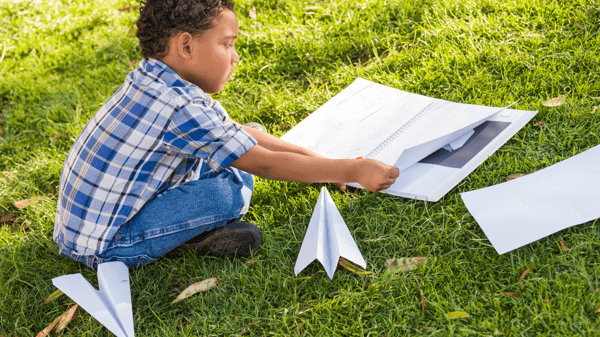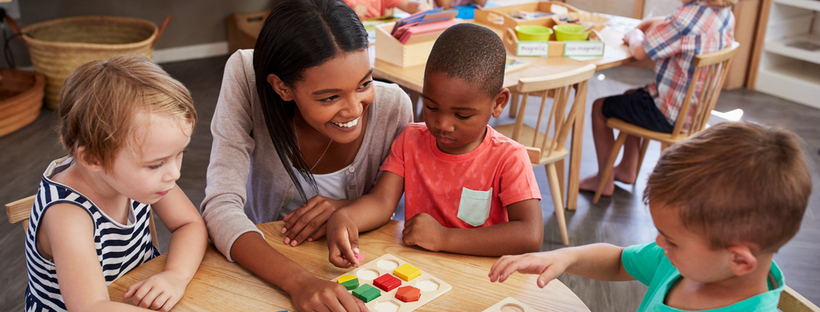On many hot summer days, my Uncle Preston would drive down from Alexandria, VA to White Oak, VA in my Aunt Margret’s silver T-Top to pick me up for one of our many adventures. Summertime was always a great time of the year only if I didn’t have to go to summer school. He would drive me back to the Huntington Metro in Alexandria, and we would jump on the train and go past the DCA airport, watching planes take off, as we ventured into DC to visit the Smithsonian Museums and my favorite, the Air and Space Museum. Walking through the front doors, you see airplanes and spaceships all around you and can sit in pilot seats, imagining flying a plane or blasting off to space. It was incredible. These experiences are just a bit of what I was introduced to as a child, but I wonder, how many children have had these same experiences?

What if you have the future Guion Stewart Bluford Jr., the second African-American to ever go to space, or Mae Carol Jemison, the first Black woman to go to space, right in front of you? These are the questions that I wondered about daily when I entered my classroom as a first-year teacher.
During my tenure as a teacher, it was common to observe my class outside exploring the woods, looking into the sky, watching videos on space, or completing multiple classroom science projects. It wouldn’t be until later that I learned that I was actually supporting Science, Technology, Engineering, and Mathematics (STEM) education, which later added the letter (A) for Arts (STEAM).
S.T.E.A.M. in Early Childhood Classrooms
As teachers, we have the ability to help kids have experiences that they may have never otherwise come across by expanding their knowledge in STEAM. It is imperative for our students of color to see themselves in STEAM fields as it is a field that we are not seen in mass numbers. By incorporating STEAM education in early childhood education, we are countering the cradle to prison pipeline and building a cradle to STEAM career pipeline. You may be asking: how do I begin to do this? Is funding available? How much time will this take? These are great questions and here are some tips.
- Explore state early learning and development standards. States have created early learning and development standards that incorporate all domains of early childhood development. Early learning standards provide content on developmentally appropriate expectations and desired outcomes, which can help focus curriculum and teaching to provide valuable learning opportunities for young children.
- Speak with teachers in higher grades. As a teacher, I began by speaking with teachers in higher grades as many had content-specific knowledge in the sciences. Having these conversations led me to crosswalk the state standards between grade levels and then the current curriculum. Though many of my students were between first and 3rd grade, we would participate with 4th and 5th grade classrooms when covering content such as sections on volcanos, the solar system and the life cycle and complete science projects together.
- Support inquiry. This exposure led to students asking even more questions which led them to reading more books and researching different facets of STEAM. I was able to connect what they saw in the experiments and the world around them to what they read in books and create new knowledge to expand their curiosity. Here are a few suggestions to encourage greater inquiry:
- Follow children’s interests
- Provide experiences that ignite curiosity
- Ask open-ended questions to encourage deeper thinking
- Expand on curiosity around STEAM topics through books such as Mae Among the Stars, a book inspired by Mae Jameson, the first African American woman to travel into space. (Find more books like this at First Book, a non-profit social enterprise committed to elevating educational opportunities for children in need.)
- Encourage collaborative learning. As an Eagle Scout, I got to engage in a journey of understanding the importance of teamwork and collaboration to successfully accomplish a task. The same idea is reflected when we have students work in groups. Have you ever thought of challenging your students to work together and accomplish a task dealing with earthquakes? Your lesson can first cover the “S” which explains what earthquakes are and what they look like. Next, you can move to the “T” as you begin explaining what a seismograph or seismometer is and their importance. Then, you can move to “E” as you begin challenging your students to “engineer” a structure that can sustain an earthquake and have them explain to you why it will work. The goal of this lesson is not to show where they are wrong or why it won’t work, but to have them begin questioning themselves and individually push themselves to think critically about what they created.
- Collaborate with local high schools. Early childhood teachers can collaborate with high school STEM clubs to have the high school students visit your classroom or share videos of explaining or carrying out their projects. Currently, there are many high schools who have begun STEM clubs in which they meet after school and complete a multitude of projects, especially those interested in Robotics.
These experiences give the high schoolers the opportunity to see themselves as teachers which, in turn, benefits your students and your opportunity to observe and interact. As a teacher, I saw this first-hand when the high school band would visit. The younger students were fully engaged because of the band students’ presence alone and automatically began taking music class even more seriously. These connections are pertinent to building bonds. - Connect with local universities and community programs. Your local colleges and universities can be another resource, particularly those that already have students in teacher preparation programs.
Many higher education institutions have community outreach components embedded where students visit local schools and do experiments with children. This past summer, Virginia State University offered a STEM camp for local students geared towards exposing young children to the science fields. This early exposure not only gives students access to experiences they may have never come across but also exposes them to college.
You can see smiles on both the child and college students’ faces when engaging in activities as they build connections, which contributes to social emotional growth as well. These higher education institutions often have faculty looking to partner with local community organizations and schools to collaborate when writing grants for new programs or identifying field experiences, which can lead to long-term partnerships and healing between the community and university.
- Hold a STEAM family event (in-person or virtual). Provide parent-child STEAM activities that are interactive and encourage curiosity.
- List children’s books that connect to STEAM topics. For children’s books that support STEAM topics, check out your local library, First Book, Colours of Us, and Read Across America.
- Encourage STEAM activities at home. Share ideas that encourage play, utilizes materials that can easily be found at home, and promotes STEAM topics. For free, science-based tips for families, check out Vroom® for children birth–five.
- Embed STEAM ideas into school-home communication. Share STEAM ideas, activities, and tips into newsletters, social media posts, family engagement software, bulletin board displays, etc.
- Connect with organizations in the community. Connect STEAM learning with organizations and programs in your community. Invite outside organizations to your next family engagement event or share community events and programs with families that encourage children and parents to learn about STEAM topics together.
In closing, I ask you to look around your classroom the next time you teach and view your students as your “little scientists” because you never know if a future astronaut may be in front of you.
Celebrate STEAM during Family Engagement Month. Click the link below for STEAM brain-building resources.
![2021-10-25 15_44_44-[MCR-1102] STEAM Blog - CCAoA JIRA and 8 more pages - Work - Microsoft Edge](https://info.childcareaware.org/hs-fs/hubfs/2021-10-25%2015_44_44-%5BMCR-1102%5D%20STEAM%20Blog%20-%20CCAoA%20JIRA%20and%208%20more%20pages%20-%20Work%20-%20Microsoft%E2%80%8B%20Edge.png?width=109&name=2021-10-25%2015_44_44-%5BMCR-1102%5D%20STEAM%20Blog%20-%20CCAoA%20JIRA%20and%208%20more%20pages%20-%20Work%20-%20Microsoft%E2%80%8B%20Edge.png)
Dr. William White, Director of My Brothers Teacher
Dr. White is currently the Director of My Brothers Teacher at the University of Washington. His research interest is on the impact of Black male teachers and grow your own programs.





